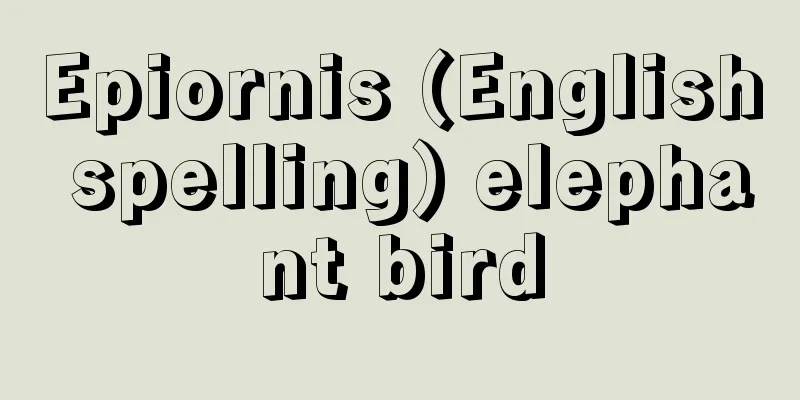Epiornis (English spelling) elephant bird

|
A huge extinct bird known only from fossils on the island of Madagascar. It is also called the Ryucho or Zoucho. A huge egg measuring 33 cm in length and 24 cm in diameter was found in the sand on the coast of Madagascar, and its volume was 148 times that of a chicken egg. From the excavated skeleton, it is estimated that the bird was 3 meters tall. Fossils of an ancestral form have been found in Eocene and Oligocene strata in North Africa, and the ancestors of this bird were widely distributed and flew around the African continent around 40 million years ago. After they settled on the island of Madagascar, which is isolated from the continent, they no longer needed to fly because there were no natural predators and it was safe, so they are said to have started living by walking on the ground. When humans settled on the island, they were hunted to extinction. It is a New Zealand bird that became extinct because it was similarly large and unable to fly, and is classified as a group of birds called ratites along with the moa, which is also called a terror bird. Although they are also ratites, the ostrich, rhea, emu, and cassowary have survived to the present day because they can run away quickly, but the Aepyornis and moa, which have short and thick metatarsals, became extinct because they could not run fast. The giant monster bird Rokh in the story of Sindbad in "The Thousand and One Nights" is believed to be this Aepyornis. [Kamei Setsuo] [References] | | | | |Source: Shogakukan Encyclopedia Nipponica About Encyclopedia Nipponica Information | Legend |
|
マダガスカル島において化石でのみ知られている絶滅した巨大な鳥。隆鳥(りゅうちょう)あるいは象鳥(ぞうちょう)ともよばれる。マダガスカル島の海岸で、砂の中から長さが33センチメートル、径が24センチメートルもある巨大な卵がみつかり、容積はニワトリの卵の148倍もあった。発掘された骨格からは、その鳥の背丈は3メートルもあったと推定されている。先祖型にあたるものの化石は、北アフリカの始新世や漸新世の地層からみつかっており、この鳥の先祖たちは4000万年前ころにはアフリカ大陸に広く分布して飛び回っていた。大陸から孤立しているマダガスカル島に住み着くようになってからは、天敵がいなくて安全なために飛ぶ必要がなくなり、地上で歩行して生活するようになったとされている。人類がこの島に住み着くようになって、狩りつくされて絶滅してしまった。ニュージーランドの、同じように大形で飛ぶことができなかったために絶滅した鳥で、恐鳥(きょうちょう)とよばれているモアなどとともに走鳥類という鳥類のグループに分類されている。同じ走鳥類でも、ダチョウ、レア、エミュー、ヒクイドリは、早く走って逃げることができるので現在も生き残っているが、中足骨(ちゅうそっこつ)が短くて太いエピオルニスやモアは、早く走ることができなかったために絶滅してしまった。『千夜一夜物語』のシンドバッドの話にある巨大な怪鳥ロクrokhは、このエピオルニスのこととされている。 [亀井節夫] [参照項目] | | | | |出典 小学館 日本大百科全書(ニッポニカ)日本大百科全書(ニッポニカ)について 情報 | 凡例 |
<<: Ebionites - Ebion is (English spelling)
>>: ABS detergent - ABS detergent
Recommend
Erwin Schrödinger
Austrian physicist. Founder of wave mechanics, he...
If-Then Format
...On the other hand, the drawback is that proces...
Rhizopus - Spider mold
A mold belonging to the zygomycete order Mucorale...
Achisu [Hot Spring] - Achisu
…In the late Middle Ages, it was called Shiramats...
Eneida
…(5) Galicia became part of Austria after the par...
Disaster prevention forest - bosairin
An artificial forest created to prevent and reduc...
Karasasaya - Karasasaya
...Its heyday was the same period as the Mochica ...
Juba II
King of Mauretania during the Roman Empire. Reigne...
River Mersey
A river that flows west through the western part o...
Tesla - Tesla (English spelling)
An abbreviation for Tesla Motors, a US electric ve...
Striped maple - Striped maple
A deciduous medium to tall tree in the maple fami...
Stripes
A striped pattern consisting of straight or curve...
Inagaki Taruho - Inagaki Taruho
Novelist. Born in Osaka. Interested in airplanes,...
Entrance and exit - Deirigoto
A term used in Noh and Kyogen. A general term for ...
Akimonto - Followers of Aki
…Mutual aid in rural areas was also cultivated by...









